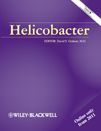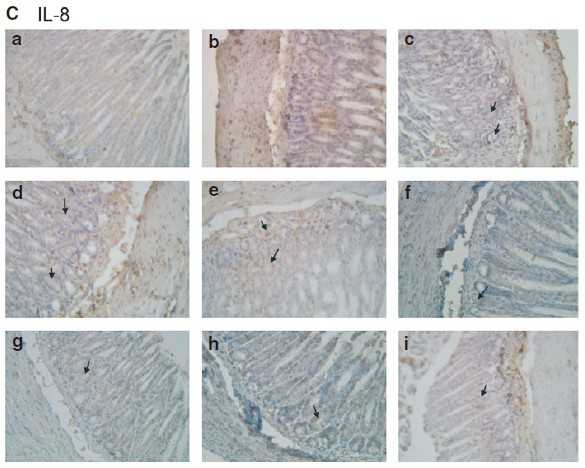Helicobacter:幽门螺杆菌耐药持续增加
2013-06-18 吴军 编译 医学论坛网
幽门螺杆菌对抗生素耐药影响了根除性治疗的效果。来自韩国的研究者JungWonLee发表题为《对抗生素原发性和继发性耐药的幽门螺杆菌在韩国普遍存在(2003-2012年)》的论文。该研究的目的就是评价幽门螺杆菌的原发性和继发性耐药在韩国的普遍性,并描述与抗生素耐药相关的风险因素。幽门螺杆菌原发性和继发性耐药在韩国持续增加,这将会严重限制未来有效根除幽门螺杆菌感染。该文发表在《
幽门螺杆菌对抗生素耐药影响了根除性治疗的效果。来自韩国的研究者Jung Won Lee发表题为《对抗生素原发性和继发性耐药的幽门螺杆菌在韩国普遍存在(2003-2012年)》的论文。该研究的目的就是评价幽门螺杆菌的原发性和继发性耐药在韩国的普遍性,并描述与抗生素耐药相关的风险因素。幽门螺杆菌原发性和继发性耐药在韩国持续增加,这将会严重限制未来有效根除幽门螺杆菌感染。该文发表在《螺杆菌(helicobacter)》杂志上。
研究于2003-2012年开展,在347例无幽门螺杆菌根除史的患者中进行原发性耐药评价,86例既往幽门螺杆菌根除失败患者中进行继发性耐药评价。通琼脂糖稀释法,对阿莫西林、克拉霉素、甲硝唑、四环素、阿奇霉素、左氧氟沙星及莫西沙星进行最小抑菌浓度检测。评价幽门螺杆菌对7种抗生素的原发性及继发性耐药率及分析其对抗生素耐药的风险因素。
研究期间发现,原发性耐药率在阿莫西林(6.3-14.9%,p=0.051),克拉霉素(17.2-23.7%,p=0.323),以及左氧氟沙星和莫西沙星(4.7-28.1%,p=0.002)中增加。继发性耐药率在甲硝唑、左氧氟沙星和莫西沙星中显著增加。在最初幽门螺杆菌根除失败的患者中,即使克拉霉素(P<0.001),阿奇霉素(P<0.001),左氧氟沙星(P=0.011)和莫西沙星(p=0.020),HP耐药性依然增加。多变量分析显示幽门螺杆菌对克拉霉素、阿奇霉素、左氧氟沙星和莫西沙星等抗生素耐药与以往的根除治疗史有关。

Prevalence of Primary and Secondary Antimicrobial Resistance of Helicobacter pylori in Korea from 2003 through 2012
Background
Antimicrobial resistance of Helicobacter pylori (H. pylori) affects the efficacy of eradication therapy. The aim of this study was to estimate the prevalence of primary and secondary resistance of H. pylori isolates to antibiotics and to characterize the risk factors associated with antimicrobial resistance in Korea.
Materials and Methods
This study was performed during the period of 2003–2012. Primary resistance was evaluated from 347 patients without any history of eradication, and secondary resistance was evaluated in 86 patients from whom H. pylori was cultured after failure of eradication. Minimal inhibitory concentration test was performed for amoxicillin, clarithromycin, metronidazole, tetracycline, azithromycin, levofloxacin, and moxifloxacin using agar dilution method. Primary and secondary resistance rates of H. pylori to 7 antibiotics were evaluated and risk factors for the antibiotic resistance were analyzed.
Results
Increase in the primary resistance rate was found in amoxicillin (6.3–14.9%, p = .051), clarithromycin (17.2–23.7%, p = .323), and both of levofloxacin and moxifloxacin (4.7–28.1%, p = .002) during the study period. Secondary resistance rate significantly increased in metronidazole, levofloxacin, and moxifloxacin. Increase of resistance occurred after initial failure of eradication therapy in case of clarithromycin (p < .001), azithromycin (p < .001), levofloxacin (p = .011), and moxifloxacin (p = .020). Multivariable analyses showed that clarithromycin, azithromycin, levofloxacin, and moxifloxacin resistance was associated with previous eradication treatment history.
Conclusions
The increased primary and secondary antibiotic resistance of H. pylori in Korea is ongoing, and it will become a significant limitation for effective eradication of H. pylori in the future.
本网站所有内容来源注明为“williamhill asia 医学”或“MedSci原创”的文字、图片和音视频资料,版权均属于williamhill asia 医学所有。非经授权,任何媒体、网站或个人不得转载,授权转载时须注明来源为“williamhill asia 医学”。其它来源的文章系转载文章,或“williamhill asia 号”自媒体发布的文章,仅系出于传递更多信息之目的,本站仅负责审核内容合规,其内容不代表本站立场,本站不负责内容的准确性和版权。如果存在侵权、或不希望被转载的媒体或个人可与williamhill asia 联系,williamhill asia 将立即进行删除处理。
在此留言










#Helicobacter#
56
#螺杆菌#
51